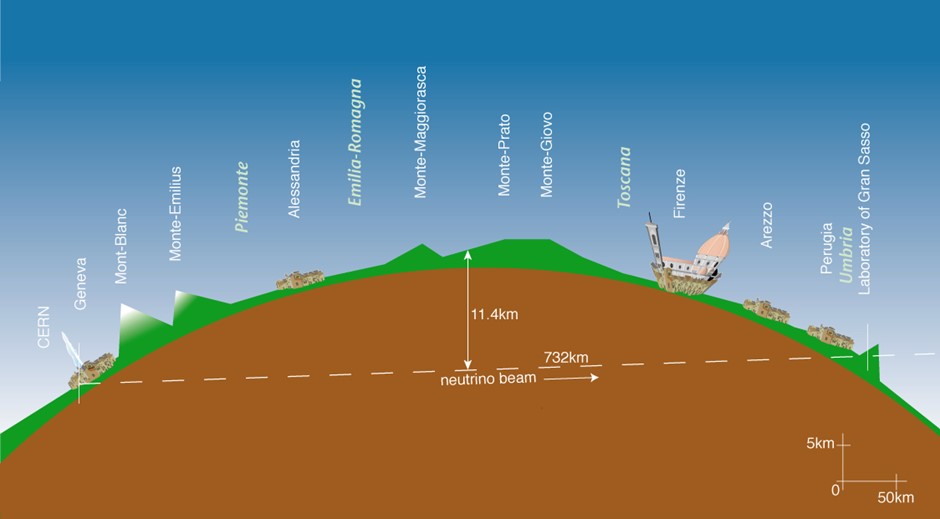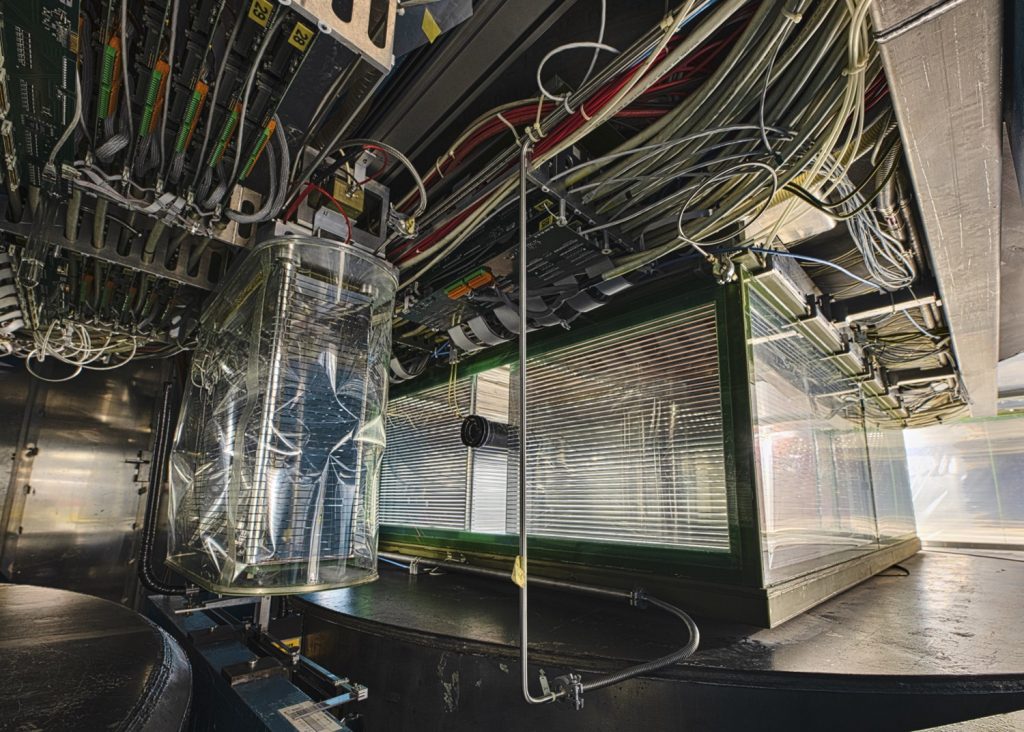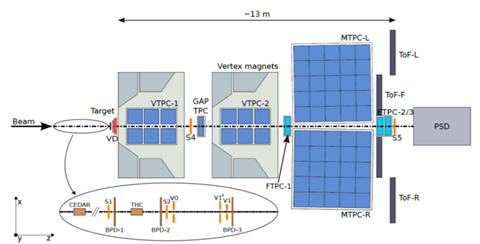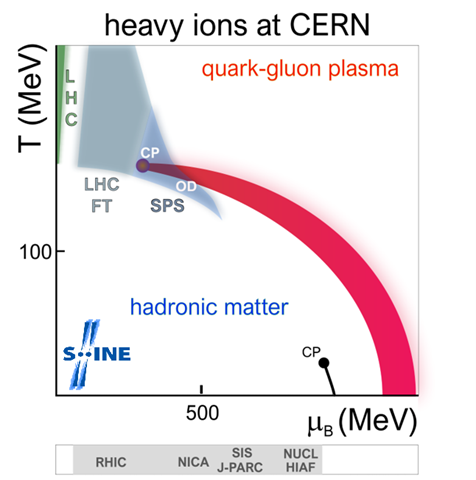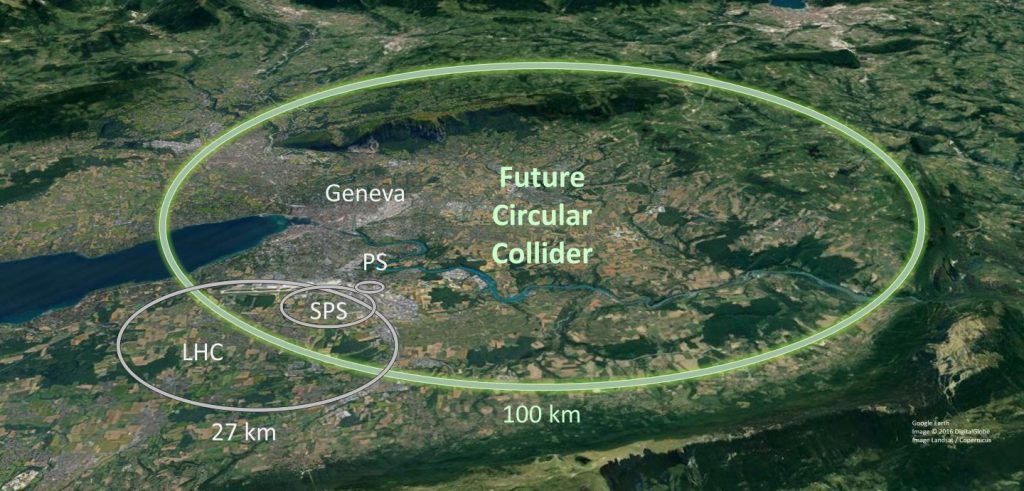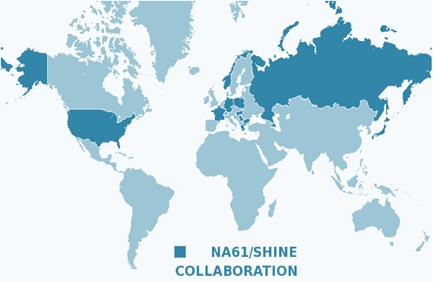A LOOK INTO THE PAST
The official cooperation of a group of nuclear physicists from the August Chełkowski Institute of Physics of the University of Silesia began when they joined the neutrino experiment ICARUS in 2001 and the experiment dealing with the measurement of heavy-ion collisions NA61/SHINE in 2010.
ICARUS – is the largest single-phase modular liquid argon detector ever built with a time projection chamber with a cryostat containing 760 tons of LAr (ICARUS T600), where one of the neutrino sources was a beam produced at CERN (project CNGS – CERN Neutrinos to Gran Sasso). The operation of liquid-argon time projection chambers is based on measurement of traces of charged particles interacting in liquid argon, measurement of energy losses due to ionization of the medium (dE/dx), and identification of interacting and created particles. Thanks to the liquid-argon technique and appropriate chambers, it is possible to study rare events (e.g., neutrino interactions or searching for so-called WIMPs – Weakly Interacting Massive Particles).
Physicists from the Institute of Physics of the University of Silesia participated in the detector test in Pavia and in measurements conducted in the underground laboratory in Gran Sasso (Italy), where the ICARUS T600 detector was installed. Analyses performed by them focused, among others, on the reconstruction of cases of interactions of neutral pions and neutrino interactions from the CNGS beam.
The ICARUS T600 detector was in operation from 2010 to 2013. During that time, data was collected as a result of the interaction, in liquid argon, of neutrinos produced at CERN and sent to Gran Sasso. Studies of atmospheric neutrino interactions were also performed. The excellent calorimetric and reconstruction resolution of the detector allowed for a broad research programme, from nucleon decay to the study of neutrino oscillations from the CNGS beam. Among the studies performed with neutrino beams, we can distinguish three main ones: (1) verification of the neutrino superluminosity phenomenon suggested by the OPERA experiment, (2) a precise study of the disappearance of muon neutrinos, and (3) the anomalous appearance of electron neutrinos. The latter’s purpose was to experimentally verify or exclude anomalies in the number of observed electron neutrinos suggested by the LSND experiment and thus to confirm or exclude the existence of the so-called sterile neutrino.
Over the years of its design, planning, and operation, the ICARUS experiment involved several dozen persons from the University of Silesia. Currently, they remain at the University and are involved in other neutrino experiments associated with CERN: Prof. Jan Kisiel, PhD, Arkadiusz Bubak, PhD, and PhD students Jacek Holeczek, MA and Kamil Porwit, MA.
Route taken by neutrinos
through the Earth’s crust from CERN to the Gran Sasso laboratory
(source: CERN, CERN-DI-0108004-01)
The second experiment, in which the scientists of the University of Silesia began to work in 2010, is the experiment NA61/SHINE. Collisions of nuclei of different sizes (p+p, Be+Be, Ar+S.C., Xe+La, Pb+Pb) and energies (from 13 to 150 GeV per nucleon) were recorded within the experiment. The experiment aimed to search for the critical points of strongly interacting matter and study the properties of the phase transition between the hadronic gas and the quark-gluon plasma. The measurements associated with this part of the NA61/SHINE experiment’s physics program were completed in 2018. During this time, physicists from the University of Silesia handled the beam detectors and beam guidance system in the experiment and data analysis. The group from the University of Silesia was actively involved in developing techniques for analyzing and identifying the produced particles. In addition, a group of scientists from the University of Silesia was engaged in building detectors for the experiment. Thanks to the Cherenkov detector built by Silesian physicists, it was possible to measure the isotopic composition of the so-called secondary beam.
TPC detector (Time Projection Chamber) inside the magnet.
Source: Inside the NA61 Detector [online], CERN Document Server https://cds.cern.ch/record/2313991?ln=en, accessed on June 2021
SP: Schematic layout of the NA61/SHINE experiment at the CERN
SPS showing 8 Time Projections Chambers (TPC),
Time of Flight detectors (ToF), calorimeter (PSD), and beam counters.
Source: NA61/SHINE home page [online], https://shine.web.cern.ch/node/16, accessed on June 2021
The NA61/SHINE experiment, in addition to measurements related to the phase diagram of strongly interacting matter, is involved in reference measurements for neutrino and cosmic ray experiments. Physicists from the University of Silesia took an active part in this part of the experiment by preparing the detector for measurements of the cross-section of the projectile nuclei fragmentation process and later analyzing the collected data.
Currently, the NA61/SHINE experiment involves Seweryn Kowalski, PhD, Szymon Puławski, PhD, Katarzyna Schmidt, PhD, Kamil Wójcik, MSc and PhD students Marta Urbaniak, MSc, Yuliia Balkova MSc and Bartosz Łysakowski, MSc. From the very beginning, the cooperation has been financed by the grants of the National Science Center (8 grants in total). Currently, the group is involved in two NCN grants (Beethoven and Grieg).
During the last 30 years at the University of Silesia, there were also theoretical works related to the operation of the Large Electron-Positron Collider (LEP) home.cern and precise calculations within the Standard Model and its extensions (Prof. Marek Zrałek, Prof. Karol Kołodziej). Prof. Henryk Czyż participated in LEP working groups on the Bhabha process and Monte Carlo generators.
CURRENT ACTIVITIES
In 2019-2021, the NA61/SHINE experiment is undergoing a major upgrade necessary for its further measurement plan. Under this plan, scheduled for 2021-2024, the experiment’s activities will focus on measuring open charm production in Pb+Pb collisions. The information from these measurements will complement the information related to the formation of the next state of matter, which is the quark-gluon plasma. Of course, reference measurements of cross-sections for neutrino experiments and measurements of cross-sections for fragmentation processes will be continued. The function of coordinator of detector modernization was entrusted to the University of Silesia. Within this task, physicists from the University of Silesia are engaged in modernizing all detector elements and constructing new detectors. Analysis of data collected during the previous stage of the experiment is also continued.
Physicists from the Institute of Physics of the University of Silesia participate in experiments currently carried out at CERN and prepare new ones. Test Beam Experiment for Hyper-Kamiokande and Future Large-scale Water-based Detectors (WCTE) is an experiment using cernovial charged particle beams. Its results will be used by the international physics collaboration Hyper-Kamiokande, in which physicists from University of Silesia work. Hyper-Kamiokande will be the largest water-based detector of Cherenkov radiation. The scientific programme of the WCTE experiment includes, among others, the determination of the performance of a new photomultiplier technology (multi-PMT), the development of calibration methods for Cherenkov detectors with water masses of several thousand tons, and the measurement of poorly studied physical processes such as the production of Cherenkov light at large angles relative to the charged particle track or ion scattering and absorption. The WCTE detector, which is being built at CERN East Area, will study the properties of such charged particles as protons, kaons, pions, muons, and electrons with momenta ranging from 200 MeV/c to 1200 MeV/c. These particles will interact with water filling a cylinder 4.1 m in diameter and 4 m high, and 128 multi-PMT modules will record the resulting Cherenkov radiation. In the second phase of the experiment, gadolinium sulfate will be added to the water to allow the recording of neutrons. Currently, the detection system components are being built, and data collection is planned for mid-2022. A group of physicists from the Nuclear Physics in Interactions and Applications research group at the University of Silesia, composed of Prof. Jan Kisiel, Seweryn Kowalski, PhD, Arkadiusz Bubak, PhD, Szymon Puławski, PhD, Katarzyna Schmidt, PhD, and Jacek Holeczek, MSc, participates in the preparation of the WCTE by performing computer simulations of the experiment. Our participation is planned in the following stages: assembly of the detector at CERN, supervision of the data collection, and analysis.
Intensive cooperation with CERN is being carried out by the theoretical research team of the Institute of Physics of the University of Silesia, “Theory and phenomenology of particle physics,” under the direction of Prof. Janusz Gluza. One of the leading research topics of the team is the phenomenology of extensions of the Standard Model of elementary particles. Investigating properties of neutrinos, non-standard gauge bosons, and searching for additional neutral and charged Higgs particles are parts of the experiment conducted at CERN – Large Hadron Collider (LHC, home.cern) and its successor, HL-LHC (high luminosity collider, home.cern), which will start operating in 2028 and will serve for the next several years. The prediction of the new physics signals is also of paramount importance for the direction of research undertaken at the Future Circular Collider accelerator (FCC, fcc.web.cern.ch), which is to be built at CERN after the HL-LHC accelerator is completed. This research in Prof. Gluza’s group is led by Bartosz Dziewit, PhD, an employee of the University of Silesia, Magdalena Kordiaczyńska, MSc and Wojciech Flieger, MSc (PhD students of the University of Silesia). Apart from searching for signals of new physics, the group is working on precise calculations within the framework of the Standard Model. The participants are Ievgen Dubovyk, PhD, an employee of the University of Silesia, Krzysztof Grzanka, MSc (PhD student of the University of Silesia) and foreign collaborators: Prof. Ayres Freitas from the University of Pittsburgh, USA, Johann Usovitsch, PhD, from the University of Mainz, Germany, and Martijn Hidding, PhD, from the Uppsala University in Sweden. The calculations performed will be the basis for the FCC’s action. More on the precise calculations conducted by the researchers from the University of Silesia can be found at: us.edu.pl.
PLANS FOR THE FUTURE
Despite the rapid development of technology and science, many fundamental questions about the nature of the Universe still remain unanswered. For example, what is the so-called dark matter, what is caused by the asymmetry between matter and antimatter?
Answers to these and many other questions occupying the minds of physicists around the world may be provided by the planned successor to the LHC, the FCC, a circular collider with a circumference of 100 km which, thanks to the use of the latest available technology, will allow to obtain up to 100 times more precise measurements than those currently available. However, constructing an experiment and making measurements is not enough; in modern physics, cooperation between theory and experimentation is needed to make discoveries. Without theoretical predictions, we would not be able to interpret the experimental results well. Thus the whole project with a total cost of several billion euros would be useless. Exciting details about the motivation for building the next accelerator and its role can be found in the study “FCC-ee: Your Questions Answered”, „FCC-ee: Your Questions Answered”. Below is an illustration of the planned FCC collider, highlighting the currently operating 27 km diameter LHC accelerator.
Aerial view showing the current ring of the LHC (27km) and the proposed new 100km
tunnel that could host different collider modes (FCC-ee, FCC-hh, FCC-he).
(source: CERN, Future Circular Collider – Image selection)
Based on the agreement between the University of Silesia and CERN, between 2017 and 2023 the theoreticians from the University of Silesia have the opportunity to visit CERN and work on the FCC project. The scientific activities of the team are also financially supported by the National Science Center under the grants obtained. A brief description of one of them, implemented in 2017-2021, can be found at www.ncn.gov.pl
In the last 30 years, the University of Silesia scientists have actively participated in experiments exploring the nature of the Universe, contributing to the development of high-energy physics at CERN. We have created teams of inquisitive and passionate scientists at the University, which we continue to develop. We have many years of intensive and exciting research ahead of us. We look forward to new theories, breakthroughs, and further scientific challenges.
COOPERATION
In concluding the above description, one should not forget about one important function of CERN, which is the development of international cooperation between scientists. CERN is the place where cultures and customs from all over the world intermingle. This is where scientists create a wonderful atmosphere of cooperation. It does not matter what country you come from and what language you speak – the one and only, so-called CERN English with different accents and often grammatical errors is valid here. The most important thing is communicating and looking deep into the matter, asking new questions, and looking for solutions. The participation of physicists from the University of Silesia in research at CERN indicates that we conduct research at a global level – we carry out the same work as other scientists at CERN. CERN can be called a forge of scientific cooperation – once established, such cooperation lasts for years, and the scientists who carry it out become world citizens. ICARUS, NA61/SHINE, FCC are cooperations not only between scientists but also between institutions. For example, NA61/SHINE is formed by 28 institutions from as many as 14 countries, including nine institutions from Poland.
Prepared by:
Janusz Gluza, Jan Kisiel,
Arkadiusz Bubak, Seweryn Kowalski,
Szymon Puławski, Katarzyna Balin






